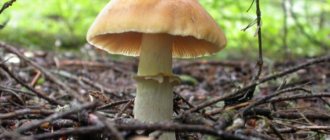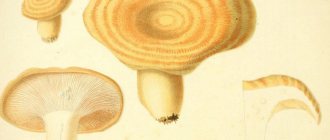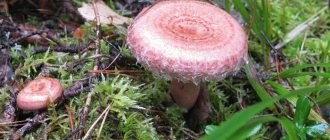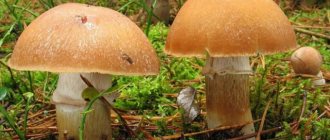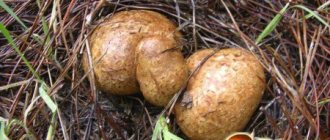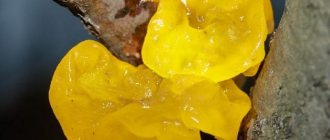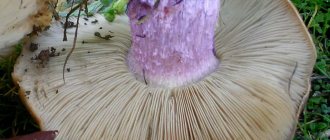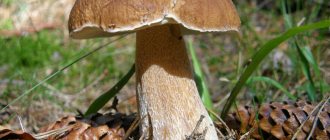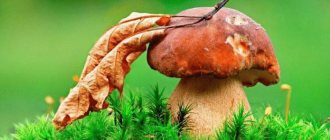The ringed cap (lat. Rozites caperatus), popularly called a hen or cockerel, is undeservedly ignored by even the most experienced mushroom pickers. This unsightly fungus from the cobweb family evokes associations with toadstools and does not seem appetizing. But if you cook it correctly, it tastes exactly like poultry. That's why these mushrooms are called cockerels or chickens.
Description and characteristics of the mushroom
The chicken mushroom belongs to the genus Cortinarius, family Cortinariaceae. Latin name: Cortinarius caperatus, Rozites caperatus, Cortinarius caperatus. In common parlance, this species is also called: Turk mushroom, goose mushroom, jaundice mushroom, Pribolothukh mushroom, cap mushrooms. Scientific names: Annular cap, White marshweed, Rosites dull.
The cap of a cockerel varies from 5 to 12 cm in diameter. In young fruiting bodies it is hemispherical and resembles a chicken egg with drooping and turned-down edges. But with age it becomes flat-convex, the edges rise, and a small hump appears on top. During periods of drought, the edges of the cap crack. The skin of the chicken is wrinkled and fibrous, and has a small coating in the form of a white coating. The color of the cap can vary from silvery-white to yellowish-pinkish-brown.
The hymenophore (lower part of the cap) is plate-type. The plates are white or yellowish in young specimens, and after the cap opens, in adulthood, they become yellow. The ocher-rusty hue of the plates of the edible mushroom distinguishes it from its poisonous companions, whose plates remain invariably white.
When cut, the pulp has a dense consistency, fibrous and watery. When cut, the color does not change; it is yellowish or whitish. The smell is pleasant, mushroom. It is worth noting that chickens are often affected by worms.
Reference! It was the special, delicate taste, reminiscent of chicken meat, that gave this mushroom its name. Many lovers of quiet hunting equate the value of this species with boletus and milk mushrooms.
The leg has a cylindrical shape, its base is slightly thickened, which resembles the characteristic features of the fly agaric. There is a membrane that, when broken, forms a ring that fits tightly around the leg. The surface is silky at the base; scales can be seen in the upper part. The color of the leg is pale yellow, the lower part is more intense.
What is another name?
This is a little-known mushroom. Many have not even heard of it, and when they come across it, they pass by, not suspecting what kind of gustatory pleasure they are depriving themselves of.
The official name of the chickens is ringed cap. It belongs to the genus Rozites (Rozites caperatus). Despite its low rating among mushroom pickers, it has many popular names. In addition to “chicken” names, his name is:
- white marshland;
- cap;
- greenfinch;
- gray sandpiper;
- green grass.
Sometimes it is called the “gray rower,” but it does not belong to their family. It differs from the real gray row in color and structural features of the leg.
Collection time and place
The ringed cap can be found almost throughout Europe and Asia, North America and the Japanese Islands. Mushrooms choose mountain coniferous forests for colonization. Preference is given to acidic soils where blueberries and lingonberries grow.
In central Russia they are most often found in mossy, slightly marshy areas. It is found almost everywhere in Belarus and enjoys well-deserved love and popularity.
Reference! The prevalence of caps in swampy areas gave people the opportunity to call them marsh bogs and marsh bogs.
From the beginning of July until the frosts, hens appear in small groups in light coniferous and mixed forests. Very often, fruiting bodies are arranged in rings (popularly called “witch’s circles”).
In some areas, the cockerel is practically unknown and is considered unfit for food, despite its positive characteristics. Fruiting time is from July to early October.
Characteristic features of the variety
Despite their geographical widespread distribution, ringed caps are undeservedly ignored
This happens due to the caution of mushroom pickers who confuse edible rosetes with its poisonous counterparts.
Chicken mushrooms really resemble the pale toadstool with its skirt, which is shown in the photo, but after studying the description and differences, you can easily recognize the edible forest delicacy.
Appearance and structure
Appearance changes as it grows. At the beginning of its development, the cap has the shape of a hemisphere with slightly curled edges, which are attached to the stem. The diameter of the cap is up to 4 cm. As it grows, the edges diverge and tear the cover, leaving a ring with a skirt on the leg to prevent tearing. The cap grows up to 10 cm in diameter and takes the shape of a wide cap with a bulge in the center.
The color of the cap is brownish-pink. In dry weather, the edges of the cap dry out and crack slightly. On the inside there are white-yellow plates of the spore apparatus, which acquire a rusty tint during the maturation of the spore powder. The outer side of the cap is dissected with thin creases, covered with a light coating. At the edge, the pollen forms scales that look like those of a fly agaric, which confuses inexperienced mushroom pickers.
The pale yellow leg is cylindrical in shape. The structure up to the ring is more silky and bright, above the ring it is scaly and pale. The pulp is dense with a pleasant mushroom smell. The color does not change when cut.
Place of distribution
The species is distributed in Europe, Asia, Japan, and the USA. In Belarus, chickens can be found everywhere. They grow throughout the area and are popular.
The favorite soil is damp and acidic, on which mixed and coniferous forests, as well as lingonberry and blueberry bushes, are well distributed. You can meet chickens both in the mountains and on the outskirts of swamps, which is why they received another name - marshlanders.
Taste and collection rules
An edible, tasty mushroom, the flesh of which resembles boiled chicken breast, and is consumed fried, stewed, pickled and salted. You should go hunting from July to October-November. If you come across a mycelium of chickens, then, without leaving your spot, you can collect a bucket, because they grow in vast plantations in a circle.
Since the marsh grass can be confused with its poisonous twins, when going for this species for the first time, you should take with you someone who understands them, or a picture of the edible and dangerous species. It is also necessary to use the main rule of mushroom pickers: if you’re not sure, don’t take it.
You should not take old, wormy or rotten mushrooms. If these have already ended up in your basket, then you shouldn’t throw them away or trample them, just prick the fruiting body onto a branch, and then, when ripe, it will shed spores and increase the yield.
How to distinguish from false, inedible
The ringed cap has two terrible doubles with which an inexperienced mushroom picker can confuse it - the fly agaric and the toadstool. You can distinguish it from a fly agaric by the following characteristics:
- the scales on the fly agaric cap extend over the entire area, but on the cap only along the edge;
- The smell of the pulp of an inedible mushroom is unpleasant, while that of an edible one is mushroom-like;
- the plates of the fly agaric are free, those of the cap are adherent to the stem;
- the fly agaric has a vulva at the base, the chicken does not.
When comparing with a pale grebe, pay attention to the following signs:
- Edible mushrooms do not have a sac-like formation at the base of the stem;
- The toadstool has fused plates, but the cap does not.
Pale toadstool often grows among caps, therefore, having discovered a rich clearing, it is necessary to inspect each fruiting body that is placed in the basket.
Growing at home and in the country
Cockerel mushrooms are grown quite successfully in summer cottages. This process is simple and accessible to any novice mushroom picker. Stumps left after cutting down trees are most often used for cultivation.
How to grow a ringed cap:
- First you need to get the spores. The caps of mature cockerels are placed on a sheet of paper so that the spores spill out.
- Pour the resulting seed into a small container of water.
- Water with spores is poured onto the stumps.
- Water from time to time.
Important! Chickens grow best on pine, spruce, birch and aspen stumps or on logs of these species.
Another method of cultivation is that the substrate is “infected” with fragments of rotten stumps with the mycelium of cockerels that grew on them. You need to take “seed material” from an area where chickens grow in colonies.
Step-by-step description of the process:
- Cavities are made in the infected stumps and grafting wood is placed there. Material with mycelium can also be secured to the end of stumps with nails.
- To retain moisture, the grafting mycelium is covered with spruce paws or pieces of moss.
- Chickens can be raised this way throughout the entire growing season.
- The mushroom grows best in spring and summer. Amateur mushroom growers note that with this method of propagation, caps bear fruit for 5-8 years.
Turk mushroom can be grown on wooden logs. How to do it:
- Take round tree trimmings 30–40 cm long and 15 cm in diameter. The trimmings are collected in spring or autumn (only freshly cut trees are suitable).
- Chocks infect in the same way as described above. But they must first be kept in a dark room. Aging period: 2-3 months at a temperature of 15-20 °C.
- Chocks are placed vertically in holes 20 cm deep. The laying interval should be 50 cm.
- Cover the infected areas with spruce paws.
- The cockerels will bear fruit twice a year for 2-3 years.
Mushroom umbrella. Mushrooms that you don't pick in vain. The umbrella is colorful.
BELIEVE: HE IS NOT A FLY AMAGRIC!!
About 20-25 years ago, when I didn’t have grandchildren yet, and my daughters hadn’t yet gone to school, someone introduced me to the giants of Russian forests. With mushrooms and umbrellas. Memory can no longer identify this person or the circumstances in which the event occurred.
But I don’t need to strain her at all to remember how I got my hands on them and took them home in the summer, which is usually called “non-mushroom” or “empty.”
MOTIFIED UMBRELLA
Mushroom - variegated umbrella (Macrolepiota procera). It is also called: large umbrella mushroom, motley turkey, large lepiota,
At that time, there were 50 times fewer cars per capita! That's for sure! Therefore, electric trains were the main mode of transport for gardeners - summer residents, fishermen - hunters and, of course, mushroom pickers.
I don’t remember how I got to the forest (even I’m not interested). But I remembered the way back forever!
This mushroom grows singly and in groups from late July to mid-October, in open areas of coniferous or mixed forests, clearings, forest edges and clearings, in gardens and parks, fields, and livestock pastures. Sometimes it forms “witch rings”.
There were almost no mushrooms in the forest. I collected only a few boletuses, a dozen boletuses (the rest were wormy), a few white boletuses and aspen boletuses. I put some young caps of the variegated umbrella there (for testing!).
Then, I decided to be original and covered the half-empty basket not with ferns or oak branches, for example. No, with the hats of mature umbrellas.
MOTIFIED UMBRELLA
By the way, the hat (exactly what kind of HAT is there at such a size!) these mushrooms have a diameter of up to 40 cm or more!!! At first it is almost spherical. Then it opens up and takes the shape of an umbrella. The whitish skin has many yellow-brown scales. In the center of the hat is a tubercle without scales.
What did I hear addressed to me and my umbrella! From: “Where are you going on public transport, yes, with fly agaric mushrooms!” Before: “A man with toadstools!” Let me pass. Otherwise they occupied the entire aisle with a basket of crap!”
MOTIFIED UMBRELLA
This did not give me any positive emotions... Only years later, I learned that, in comparison with other representatives of this family, the variegated umbrella has the highest taste. In Western European countries, it is generally considered a delicacy.
Leg: up to 40 cm, up to 3 cm in diameter, cylindrical, hollow, hard, brown, covered with brown scales. The ring on the stem is free, i.e. it can be moved up and down.
The Germans make a special roast from hats, called “Wiener Schnitzel” and revered as a delicacy. In France, it is also considered a delicacy and is used to prepare gourmet dishes. In the Baltics, whole umbrella hats, breaded in breadcrumbs, are served as a delicacy in elite restaurants.
Pulp: strong, white, loose, thick, somewhat harsh in old mushrooms (very hard in the stem), with a pleasant smell and nutty taste.
What to cook from a colorful umbrella?
Variegated umbrella
Young caps are fried in butter. The taste is reminiscent of chicken with a nutty flavor. You can cook them like pancakes by dipping the whole thing in beaten eggs, dredging in flour and frying.
By the way, if you decide to collect umbrella mushrooms, do not throw away their stems! Yes, they are very tough and fibrous. But if you dry them and grind them into powder, you will get an excellent seasoning with a pronounced mushroom taste and smell.
And, personally, I make excellent sauces, seasonings and gravies from the stems of umbrella mushrooms.
These mushrooms are very tasty in the form of a filling for pies along with fried onions. Suitable for soups, salting, pickling and drying.
THANK YOU TO EVERYONE WHO READ!
False doubles
Rosites dullus has dangerous analogues, so even an experienced mushroom picker should know what they can look like, so as not to confuse edible species with poisonous ones in the forest. You can find out about dangerous chicken-like look-alikes, as well as about completely edible species, in their tables.
| Name | Differences | Places of growth | Edibility |
| Cobweb | The presence of fibrous remains of the bedspread on the leg | Found in mixed and coniferous forests | Inedible |
| Mushroom ram | The external differences are quite impressive: the mushroom has a different shape, consists of numerous flat, thin, semicircular or spade-shaped caps 4-10 cm in diameter, sitting on repeatedly branching stalks that merge into a common base. These species have only a common popular name. | Grows from late June to late September in broadleaf | Edible, very rare |
| Forest champignon | The flesh turns red when broken, the plates are first white, then reddish, the cap is rusty-brown. | It grows from July to October in coniferous and mixed forests, especially often found near ant heaps. | Edible |
| Death cap | White cap, loose, white plates, a stalk swollen at the base, with a volva and a white membranous ring | Widely distributed in the temperate zone of Europe and Asia. Grows in deciduous forests from late summer until November. | Yadovita |
| fly agaric | There are whitish scales and a powdery coating on the cap, an ocher color of the spore powder (poisonous fly agarics have white spore powder), and the absence of volva. In old specimens of the ringed cap, the hymenophores are rusty-brown in color, while in fly agarics it remains white until old age. | In Russia it is widespread. The growing season is from August to October. | Poisonous |
Photos will help you recognize poisonous relatives.
The chicken mushroom has a “namesake” - the quonka mushroom, the ram mushroom, the cabbage mushroom, the coral mushroom, the quokka mushroom, the chicken of the woods, the dancing mushroom, the turkey tail or Grifola curly.
Despite the similar name, these are completely different species. The bush-like shoots of Grifola pseudocaps have clearly visible legs and visually resemble cauliflower or coral bushes.
Chicken (Cockerel) mushrooms, step-by-step cooking recipes + photos
Chickens have always been considered a delicious representative of the mushroom world, easily prepared at home. A variety of cooking options allow you to convey amazing taste and captivating aroma, both in first and second courses, snacks for strong drinks and salads, and preparations for the winter. With a little time, any housewife can put lids on delicious pickles and preserves.
Heat treatment
The fourth category of edibility indicates the need for cleaning from forest contaminants, washing and double boiling. Mushrooms are dealt with immediately after returning from the forest to prevent spoilage of the product, following the following step-by-step instructions:
1) cleaning and rinsing under running water. At this point, the skirt is removed and the fruits are inspected for worms. Unusable mushrooms are thrown into the trash, and the rest are placed in a pan, cut into large pieces;
2) fill the pan with running water and turn on the burner, setting a low temperature;
3) boil until boiling, and then drain the mushrooms through a colander and rinse under running water;
4) then re-boil using a clean pan and fresh filtered water;
5) after boiling again, the chicken mushrooms are again drained through a colander, washed and lightly dried on paper towels to prevent additional moisture from entering during the main preparation of the dish you like.
Marinating and salting hot and cold
There are two technologies for preparing mushrooms, hot and cold. Each of the options deserves separate consideration, despite the variety of recipes provided today.
In a barrel
Salting marsh marshes using the cold sourdough method involves preparing the preserved food in an oak barrel with cherry leaves, horseradish and oak leaves. At the time of steaming, juniper branches are added, which have disinfecting properties for better storage.
Pre-heat-treated mushrooms are placed in layers in containers. Each layer is well salted and strewn with leaves of fruit bushes, maple and horseradish. Finally, pure spring or mineral water without gas is poured in. A wide plate or lid is placed on top of the workpiece and pressure is placed. The workpiece is left in a cool, dark place for exactly a week.
After 7 days, the pressure is lifted to remove the formed foam and drain the water. The barrel is washed and dried. Umbrellas of dill, currant, oak and horseradish leaves are placed at the bottom of the container. The mushrooms are laid with 10-15 g of table salt on each layer. Place a lid on top and press down. The workpiece is left in a cool place for 45-50 days until fully prepared.
Evaluation of taste, medicinal properties and benefits
The slices have a delicate, unique taste. Due to their delicate consistency, they are very reminiscent of chicken meat, and their nutritional qualities are not inferior to champignons.
Ringed cap mushroom - useful properties:
- Regular but moderate consumption of rooster helps lower blood sugar and cholesterol levels, normalizes blood pressure, and helps fight arrhythmia;
- reduces the likelihood of oncological processes and infectious diseases;
- chickens are an excellent antioxidant, they have anti-inflammatory and antiviral effects:
- in oriental medicine, caps are used to treat kidney diseases and remove gallstones;
- Mushroom brine from cockerels is popularly considered an excellent hangover cure.
Composition and calorie content
Cockerel mushrooms have a rather rich chemical composition:
- carbohydrates (glucose and fructose);
- minerals (magnesium and phosphorus, iron and calcium, selenium and manganese, copper and potassium, sodium and zinc);
- vitamins (thiamine, riboflavin, folic acid, nicotinic and pantothenic acids, folates and choline, betaine and tocopherol, tocotriene, vitamins C, B6, B12, E, D, D2, D7, K1);
- lipids (saturated fatty acids, polyunsaturated fatty acids);
- amino acids (leucine and lysine, methionine and tyrosine, valine and arginine, histidine and serine, aspartic and glutamic acids).
Nutritional value of caps (per 100 grams):
- proteins – 3.09 g;
- fats – 0.34 g;
- carbohydrates – 3.26 g.
Calorie content – 22 calories.
Are chickens bad for your health?
There is no clear answer to this question. However, it is worth considering that chicken mushrooms are harmful to the health of pregnant and lactating women, children under 12 years of age, and people with exacerbations of chronic diseases.
You cannot collect or eat any mushrooms that grow near major highways, highways, or near factories. Even properly processed such fruits can be harmful to health and cause poisoning.
Edibility
The caps of blushing umbrellas are mainly suitable for culinary use, since the flesh of the legs is noticeably tougher.
The collected mushrooms are freed from forest debris, scales are removed, washed, and then boiled and fried without any additional processing. They are suitable for drying and pickling. Connoisseurs and connoisseurs especially recommend preparing a shaggy umbrella by frying it in a sufficient amount of oil. Then its flesh acquires the most pronounced taste of chicken. During the mushroom season, the red umbrella is a fairly easy forest prey, because it grows in large groups, and not everyone knows the edibility of this mushroom.
It is only important to remember that in some regions this mushroom is listed in the Red Book
Interesting Facts
- The spore powder of the annular caps is ocher in color and leaves marks similar to rust on the hands.
- Betta mushrooms prefer acidic soils where blueberries and lingonberries grow. Most often they can be found in the neighborhood of these plants.
- In European countries, the ringed cap is not considered a delicacy.
Chicken mushrooms are an excellent, versatile type of fruiting body. Once you try them marinated or fried, you will certainly remain a fan of cockerels. But when collecting them in the forest, you should look very carefully at the forest gifts so as not to confuse their poisonous relatives with caps.
Information sources
- Grunert G. Mushrooms / trans. with him. — M.: “Astrel”, “AST”, 2001
- Lesso T.
Mushrooms, key / trans. from English L. V. Garibova, S. N. Lekomtseva. — M.: “Astrel”, “AST”, 2003 - Reference guide: Mushrooms / resp. for the release of Yu. G. Khatskevich. — Mn.: Harvest, 2002
